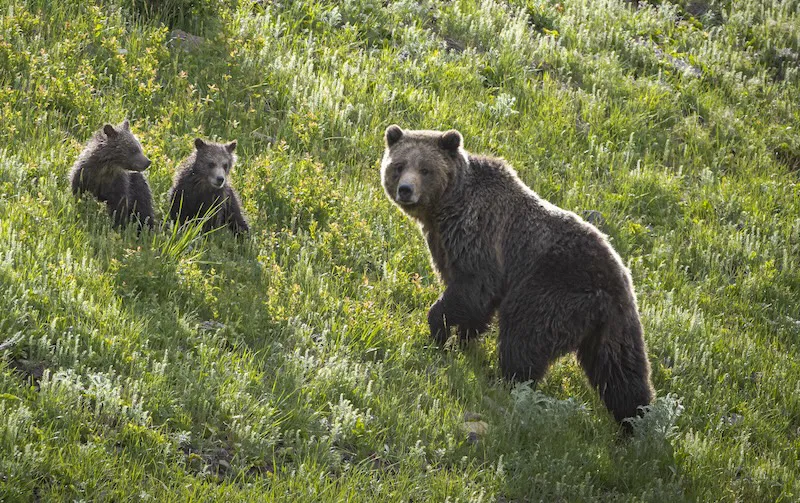Powerful Prospectors
Created Creature
by Valerie Lang on September 15, 2024In 1848—over 150 years ago—gold was discovered in California!
Back then, this sunny state had no amusement parks, resorts, or shopping malls. It was part of the rugged area in the United States that people called the Wild West. But that didn’t stop people from moving into that wilderness to search for gold. These people were called prospectors because they prospected, or dug, for gold. They often used tools like pickaxes and even explosives to get to the shiny treasure.
But one creature was prospecting in the Wild West many years before gold was ever found. The powerful grizzly bear uses the built-in digging tools God gave bears on the sixth day of creation to search for its own kind of treasure.

Muscles Made for Mining
One of the ways you can tell a grizzly bear apart from a black bear is the hump on the grizzly’s back. Unlike a camel, a grizzly doesn’t use its hump to store water. A grizzly’s hump is just a big bunch of muscles attached to its shoulder blades and arms. These muscles give the bear the strength to dig for food and shelter.
A grizzly’s muscles are impressive on their own—they can lift up to 1,000 pounds (the weight of five adult humans). But God paired those muscles with another powerful prospecting tool: long, straight claws that can grow up to four inches long. With its built in “power tools,” the grizzly can move hard-packed dirt and rocks without using explosives.
Fastest Bear in the West
The muscles in the grizzly’s hump makes this bear quick on its feet! Grizzlies can sprint up to 35 miles per hour. Because the top speed of a North American black bear is only 30 miles per hour, the grizzly holds the title of Fastest Bear in the West.
Rootin’ Tootin’ Treats
Before sin brought death into the world, the first members of the bear kind that God created were completely plant eaters. But modern grizzly bears are omnivores—they eat a combination of meat and plants. Their big bodies and sharp teeth might make us think these bears are bigger fans of burgers than broccoli. But the truth is, their diet is more plants than meat. One of their favorite things to eat is plant roots. Getting to these underground treats is a lot more work than picking a berry. For a grizzly, it’s worth it. Starchy roots are a great source of energy!
In places where veggie meals are harder to find (like some parts of the Rocky Mountains), grizzlies snack on another surprising food: moths. Every summer, millions of small, brown miller moths migrate to the Rocky Mountains where waiting grizzlies can feast on as many as 40,000 of the insects a day! Grizzlies will often use their strong arms to flip over large rocks where the moths hide. The bears can then scoop them out of the soil.
Miller moths are so fatty and nutritious that some biologists call them “bear butter.” In just one month, a grizzly can eat enough of them to get one-third of the fat it needs to prepare for the winter. Roots and moths might not seem like treasure to a human, but for a hungry grizzly, finding either is striking it rich.
Fun Facts
- Though grizzlies are often brown, their fur can also be tan or black.
- A grizzly bear’s bite is strong enough to crush a bowling ball.
- Grizzlies are natural gardeners. When they dig in the ground, they bring to the surface soil that’s rich in nitrogen (a natural chemical that plants need to grow).
- A pair of grizzly bears once lived on the White House property after they were given to President Thomas Jefferson.

Carving out Camp
When cold weather comes along, many grizzly bears take a super long nap called hibernation. Sleeping bears burn less energy than digging bears. By hibernating, grizzlies save energy during a time of year with fewer opportunities for digging up a snack. Grizzlies eat a lot before they hibernate because once they go to sleep, they may not wake up to eat again for months.
Grizzlies use their digging skills to carve out a den. Dens provide a safe place for grizzlies to ride out the winter in a deep sleep. The den usually has an entrance large enough for the grizzly to crawl into, a tunnel, and a cozy space for the long winter nap.
Designed for Digging
Surviving out West is no walk in the park (er—mountains). It’s hard work! But God wisely created his creatures with the ability to scratch out a living even in harsh environments. The grizzly bear’s flexible diet, fantastic strength, and fierce claws are all evidence that God knew exactly what this powerful prospector would need.
Kids Answers Magazine
The Wild History of Horses
Today, horses in all sizes and colors gallop across the world—but what do all these breeds have in common?
Browse Kids Issue- © 2025 Answers in Genesis
- Privacy Policy
- Contact
- About

